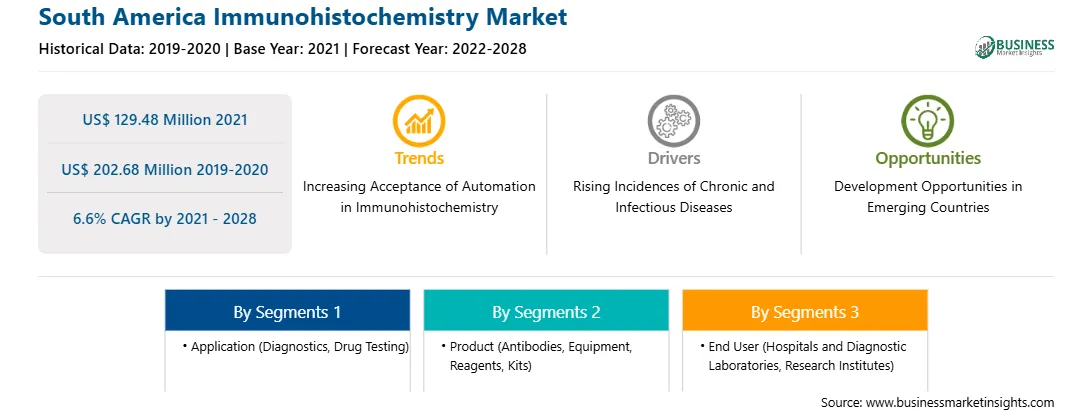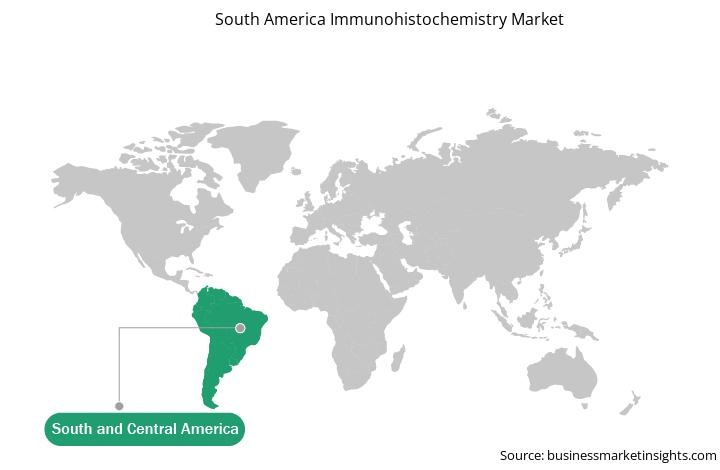Major countries included as a part of analysis for SAM includes Argentina, Brazil, and Rest of SAM. Brazil led the market in 2021. Brazil is the largest economy in Latin America, and its healthcare sector is distributed between public and private parties. The local manufacturing is restricted to consumables and ordinary articles, and there are few high-tech devices manufacturers. Therefore, Brazil imports many medical devices from other countries. Cancer is one of the primary epidemic diseases, and the number of people diagnosed with cancer has reached duplicated in the past three decades. According to data presented in an article, Revista Brasileira de Cancerologia 2018, during 2018–2019, there would be ~600,000 new cases of cancer in the country. According to the VanEck Research report published in 2017, the diagnostics market in Brazil is growing. There are around 22,000 laboratories spread across Brazil. The top four players in the market are the top four market participants— Diagnósticos da América S.A. (DASA), Fleury S.A., Centro de Imagem Diagnósticos S.A. (Alliar), and Instituto Hermes Pardini S.A. (Hermes Pardini). The key factor for the growth of diagnostic market is growing aging population. The report also mentioned that 52% of the total population will be 45 or above by 2050. Based on the factors mentioned above, Brazil is likely to serve various growth opportunities for the immunohistochemistry market players during the forecast period.
Countries in SAM, especially Brazil, are highly affected due to the COVID-19 outbreak. The outbreak has stringently affected medical services in the region. Also, the nations are famous for medical tourism, which is also influenced by the pandemic. Brazil, Argentina, Uruguay, Chile, Peru, and Colombia are affected by the second wave of the COVID-19 outbreak. According to Worldometer, as of September 3, 2021, Brazil reported 558,597 casualties and 21 million new COVID-19 cases. There were 5.2 million new cases in Argentina, a sign of the second wave of COVID-19 outbreak. It is anticipated that SAM will impose a second lockdown, which will eventually hamper the healthcare industry in the region. Brazil, Argentina, Uruguay, Chile, Peru, and Colombia are concerned by the second wave. Amongst which Brazil has registered the majority of the deaths.

Strategic insights for the South America Immunohistochemistry provides data-driven analysis of the industry landscape, including current trends, key players, and regional nuances. These insights offer actionable recommendations, enabling readers to differentiate themselves from competitors by identifying untapped segments or developing unique value propositions. Leveraging data analytics, these insights help industry players anticipate the market shifts, whether investors, manufacturers, or other stakeholders. A future-oriented perspective is essential, helping stakeholders anticipate market shifts and position themselves for long-term success in this dynamic region. Ultimately, effective strategic insights empower readers to make informed decisions that drive profitability and achieve their business objectives within the market.

| Report Attribute | Details |
|---|---|
| Market size in 2021 | US$ 129.48 Million |
| Market Size by 2028 | US$ 202.68 Million |
| Global CAGR (2021 - 2028) | 6.6% |
| Historical Data | 2019-2020 |
| Forecast period | 2022-2028 |
| Segments Covered |
By Application
|
| Regions and Countries Covered | South and Central America
|
| Market leaders and key company profiles |
The geographic scope of the South America Immunohistochemistry refers to the specific areas in which a business operates and competes. Understanding local distinctions, such as diverse consumer preferences (e.g., demand for specific plug types or battery backup durations), varying economic conditions, and regulatory environments, is crucial for tailoring strategies to specific markets. Businesses can expand their reach by identifying underserved areas or adapting their offerings to meet local demands. A clear market focus allows for more effective resource allocation, targeted marketing campaigns, and better positioning against local competitors, ultimately driving growth in those targeted areas.

The SAM immunohistochemistry market is expected to grow from US$ 129.48 million in 2021 to US$ 202.68 million by 2028; it is estimated to grow at a CAGR of 6.6% from 2021 to 2028. Immunohistochemistry (IHC) refers to an important application monoclonal and polyclonal antibody for tissue determination and distribution of antigens of particular disease. It is majorly used to detect several infectious disorders like dengue, hepatitis, human immunodeficiency virus (HIV). Chronic medical conditions such as obesity, cancer, diabetes, heart disease, and stroke, are also considered to be the primary major applications of immunohistochemistry that helps in the diagnosis of these diseases. Diabetes is prevailing at a high rate in the geriatric population across the region. The prevalence of diabetes is more in overweight and obese people. The obesity rates have been increasing rapidly in developed as well as developing economies across the region. Factors such as unhealthy lifestyle and sedentary life are among the major for the rise in the number of obese individuals. Cardiovascular diseases (CVDs) include cerebrovascular disease, rheumatic heart disease, coronary heart disease, and other conditions. It is the most significant cause of morbidity and mortality across the region. Furthermore, there has been a rise in cancer incidence and mortality rates all over the region, making cancer the leading cause of death. Such an increase in the incidence of chronic and infectious diseases is expected to create a demand for immunoassay tests around the SAM region.
In terms of product, the antibodies segment accounted for the largest share of the SAM immunohistochemistry market in 2020. In terms of application, the diagnostics segment held a larger market share of the SAM immunohistochemistry market in 2020. Further, the hospitals and diagnostic laboratories segment held a larger share of the SAM immunohistochemistry market based on end user in 2020.
A few major primary and secondary sources referred to for preparing this report on the SAM immunohistochemistry market are company websites, annual reports, financial reports, national government documents, and statistical database, among others. Major companies listed in the report are Abcam plc; Agilent Technologies, Inc.; Bio SB; BIO-RAD LABORATORIES INC.; Danaher; F. HOFFMANN-LA ROCHE LTD.; MERCK KGaA; PerkinElmer Inc.; and THERMO FISHER SCIENTIFIC INC.
The South America Immunohistochemistry Market is valued at US$ 129.48 Million in 2021, it is projected to reach US$ 202.68 Million by 2028.
As per our report South America Immunohistochemistry Market, the market size is valued at US$ 129.48 Million in 2021, projecting it to reach US$ 202.68 Million by 2028. This translates to a CAGR of approximately 6.6% during the forecast period.
The South America Immunohistochemistry Market report typically cover these key segments-
The historic period, base year, and forecast period can vary slightly depending on the specific market research report. However, for the South America Immunohistochemistry Market report:
The South America Immunohistochemistry Market is populated by several key players, each contributing to its growth and innovation. Some of the major players include:
The South America Immunohistochemistry Market report is valuable for diverse stakeholders, including:
Essentially, anyone involved in or considering involvement in the South America Immunohistochemistry Market value chain can benefit from the information contained in a comprehensive market report.